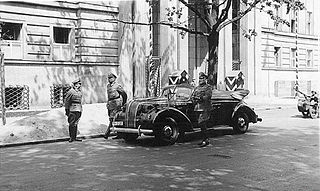Wolfgang Birkner
Wolfgang Birkner (27 October 1913 – 24 March 1945) was a German SS functionary with the rank of SS-Hauptsturmführer, and the Holocaust perpetrator in World War II. Birkner served as the KdS Warschau (Komandeur der Sicherheitspolizei) in Warsaw following the German invasion of Poland in 1939.
After the German attack on the Soviet forces in eastern Poland during Operation Barbarossa, Birkner and his Einsatzkommando were deployed in the newly-formed Bezirk Bialystok district in the Army Group Centre Rear Area due to reports of alleged Soviet guerrilla activity. Birkner arrived in Białystok from the General Government on 30 June 1941, sent in by the SS Police commander Eberhard Schöngarth on orders from the Reich Main Security Office. As veteran of Einsatzgruppe IV from the Polish Campaign of 1939, Birkner was a specialist in rear security operations.[1]

Kommando Bialystok
Birkner was appointed chief of the Kommando Bialystok under Arthur Nebe, commander of Einsatzgruppe B. Birkner's death squad was made up of 29 Security Police SS men, as well as Gestapo functionaries. It was one of several units summoned at around the same time by Schöngarth stationing in Kraków, to meet the new threat of Russian partisan warfare south-east of East Prussia with local Jews being suspected as participants. Birkner and his Einsatzgruppe committed mass murder in and around Białystok.[2] In the two initial months of operation, between 30 June and 28 August 1941, they had claimed the lives of 1,800 Jews. Birkner was promoted to the rank of SS-Hauptsturmführer Kriminal-Kommisar (the equivalent of a police captain) on 20 April 1943. He was killed in the Pomorze Province on 24 March 1945.[3]
Birkner was investigated by the West German prosecutors in 1960, prior to a court trial of the SS commander Hermann Schaper, who had directed parallel mass murders by Kommando SS Zichenau-Schröttersburg in the same area,[4] including many villages and towns of eastern Poland such as Radziłów, Tykocin, Jedwabne, Łomża, Rutki, Wizna, Piątnica, and Zambrów.[5]
Notes and references
- ^ Tomasz Szarota (2–3 December 2000). "Do we now know everything for certain? (translation)". Gazeta Wyborcza. Retrieved 13 May 2011.
- ^ Piotr Wróbel (in) Dagmar Herzog (2006). Lessons and Legacies: The Holocaust in international perspective. Northwestern University Press. p. 392. ISBN 0-8101-2370-3. Retrieved 13 May 2011.
- ^ Tomasz Szarota (April 2001). "Reflections on national stereotypes". Więź. Retrieved 14 May 2011.
- ^ Alexander B. Rossino, historian at the United States Holocaust Memorial Museum in Washington, D.C. (2003). "Polish "Neighbors" and German Invaders: Contextualizing Anti-Jewish Violence in the Białystok District during the Opening Weeks of Operation Barbarossa". Polin: Studies in Polish Jewry, Volume 16.
Cited by Bogdan Musiał in: "Konterrevolutionäre Elemente sind zu erschiessen": Die Brutalisierung des deutsch-sowjetischen Krieges im Sommer 1941, (Berlin: Propyläen, 2000), pp. 32, 62. Also, cited in German archives of Birkner's postwar investigation at: Auswertung der Ereignismeldungen zu den Judenerschiessungen in Białystok im Juli 1941 in ZStL, 5 AR-Z 56/1960, pp. 4ff.
{{cite web}}:|access-date=requires|url=(help); Missing or empty|url=(help)CS1 maint: multiple names: authors list (link) - ^ Thomas Urban, "Poszukiwany Hermann Schaper", Rzeczpospolita, 01.09.01 Nr 204. Template:Pl icon
